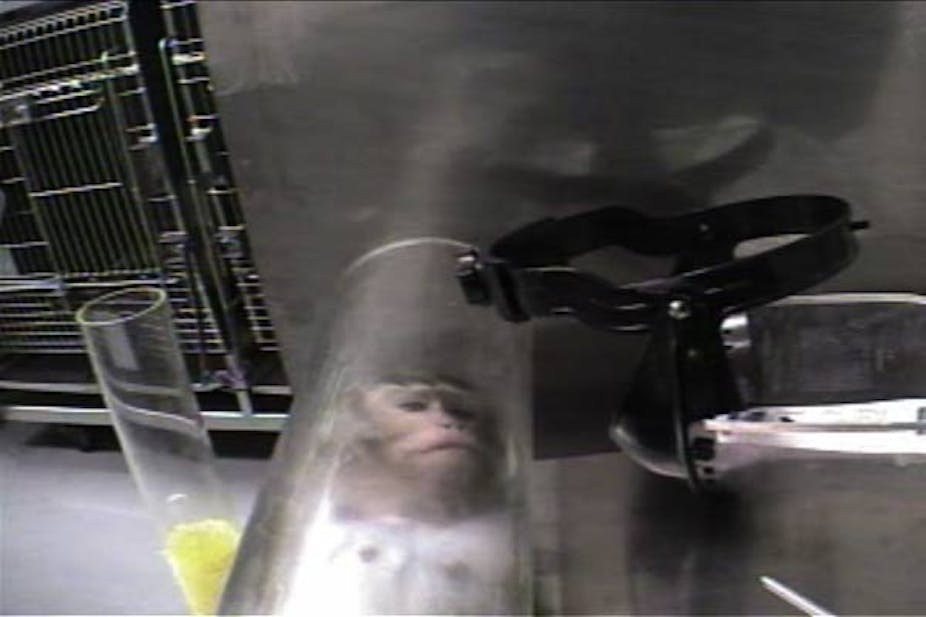While most people are aware that animals are used in biomedical research, few have any idea about the numbers of animals or the physiological and psychological “challenges” they endure.
Ask yourself how many research animals are used and killed in Australia every year? Which species are involved? Do Australian researchers use cats and dogs and non-human primates? What do the animals go through exactly?
Questions like these go to the heart of the ethical debate over using animals — a debate all of us have an interest in.
We all benefit from animal research. We take drugs and use chemical products that are tested on animals. We undergo new surgical procedures that have been practiced on animals.
As taxpayers, we finance a great deal of animal research through the auspices of NHMRC.
We care about animal welfare and have it in our power to influence how animal research is regulated.
Our public interest in animal research is beyond dispute. After all, researchers must keep records of the numbers of animals they use and must declare the level of pain and suffering the animals endure. This data is passed on to regulators who make it available to the public in annual reports such as NSW Animal Research Review Panel Annual Report.
The problem with the existing reporting system, however, is that animal use data is only seen by people who have already made up their minds on the issue: researchers and animal rights activists. Few people outside the animal research and animal advocacy communities have the time or inclination to download, let alone read, voluminous annual reports.
From a public policy point of view, widespread ignorance about animal research is not good. As John Stuart Mill pointed out, good public policy is the product of informed debate after exposure to challenging issues. Thus, if we want to strike the right balance between scientific progress and animal welfare, we need to expose animal use data to people who are not partisans of one side or the other.

My suggestion is this: when they promote their research in the media, scientists could disclose details of their animal use. Journalists or public relations officers could then weave the information into their stories or press releases.
For example, in a report or press release about a diabetes study in which rats were fed a high fat diet, the journalist would say something like, “a total of 27 rats were used in the study” or “at the completion of the study 18 mice were euthanized” or “during the study the mice were subjected to minor physiological challenges”.
Another approach could be a general disclaimer-type statement at the beginning or end of the narrative in much the same way as the origin of political advertisements are disclosed during election campaigns.
Why would a researcher want to be more open about their use of animals?
Because researchers already accept they have obligations to animals and the public that govern their conduct within the laboratory. All I am doing is pointing out that the laboratory wall is an arbitrary boundary. A researcher’s animal ethics-related public-interest responsibilities extend to any public communication about their research.
If their research is conducted in accordance with the Australian Code of Practice for Care and Use of Animals in Scientific Purposes, then researchers have nothing to hide or be ashamed about. Indeed, their research is bound to have widespread public support and greater disclosure can only bolster its democratic legitimacy.
Why would journalists or public relations officers want to include animal use data in stories and press releases?
Because, believe it or not, ethical norms and codes of ethics in both journalism and public relations support the inclusion of animal use data in science reporting. To the extent that animal use data is included in a story or press release, it serves to produce more balanced and genuinely “dialogic” public interest-focused reporting.
Besides, it is not as if the insertion of data into a wider narrative will change the overall tenor of the story or compromise any news values. At most it will involve inserting a few figures and a sentence or two.
Will researchers be vulnerable to violent retaliation from animal rights activists?
Not likely. Extremists already know about animal use data and where to find it. The effect of wider dissemination will simply be to inform people who are not disposed to violence about a matter of serious public interest.
Will researchers be vulnerable to social admonition?
Perhaps, but apart from ASIO agents who must remain anonymous for reasons of national security, no other professionals can expect protection from the disapproval of friends and family. Greater public disclosure will bring animal research into line with other legal but contentious professions.
Finally, would the wider dissemination of animal use data lead to a downturn in research?
This too is unlikely, given the enormous political clout of the research lobby and widespread public support for properly regulated research. But in a democracy, if the public want to restrict a practice - like slavery or the production of CFCs - then that’s the way it goes.
News reports about animal research tend to be, as US communications researcher Sharon Batt puts it “embellished narratives of innovation, hope and scientific heroism.” The inclusion of animal use data in news stories would enable researchers and journalists alike to play a part creating a more open and publicly accountable animal research culture.

